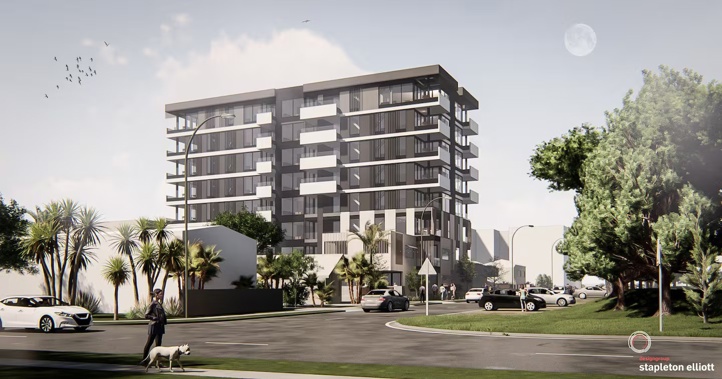
A few blocks from the site of a proposed $100m+ retirement village under fire from neighbours, other Mount Maunganui locals are fighting plans for high-rise apartments – also on former publicly-owned land. But not all Mounties are against the suburb growing upwards. Megan Wilson reports.
A Mount Maunganui resident of 66 years believes the suburb will become “a future slum” of traffic, noise and litter if a proposed eight-storey apartment building goes ahead.
A neighbour says, in their view, she will be “shadowed out completely”, a ratepayers association fears Mount Maunganui becoming “a Gold Coast”, and 80 of 88 public submissions oppose the project.
People welcoming the proposed build opposite Blake Park, however, say apartment living is the “only way” forward and will help businesses thrive.
The developer says there is “significant demand” in the suburb and communities in high-growth areas must realise urban environments will change – similar to other cities worldwide.
Structure Properties has applied to Tauranga City Council for resource consent to redevelop 8 and 10 Hinau St.
It proposed an eight-storey, 29.95-metre residential apartment building with up to 65 units and 54 car parks – 37 of those in three-level mechanical stackers.
Artist's impression of the proposed eight-storey residential apartment building on Hinau St in Mount Maunganui.
It comes as Tauranga awaits a final decision by an independent panel on the council’s proposed Plan Change 33, which would allow greater housing intensification in urban areas in response to Government policy changes.
Some fear its increased permitted building heights would destroy Mount Maunganui North’s “iconic character”.
The council said that through Plan Change 33, developments such as this within 400m and 800m of the Mount North commercial centre could be enabled to 16m (four storeys) through a restricted discretionary resource consent process. This would ultimately be decided by an independent commissioner.
The plan change could also enable a $100 million-plus retirement village on nearby Pitau St opposed by neighbours. The Pitau St and Hinau St sites were former council elder housing villages sold for private development.
Local believes apartments ’stealing’ the sky
Susan Hodkinson has lived in Mount Maunganui since 1958: “We have felt every change. This is a change too far.”
She told the Bay of Plenty Times she was concerned about the Hinau St building, in her view, “stealing” the sky, sunshine, and parking.
“Maybe high-rises can go on a green field where there’s no one to be shaded …
“And also in Tauranga where there’s empty buildings … where there’s no quality of life going to be compromised.”

Susan Hodkinson is against the proposal to build a high-rise residential apartment block on Hinau St in Mount Maunganui. Photo / Alex Cairns
In her council submission, Hodkinson said Mount Maunganui was “full” and believed the proposal would lead to it being “over capacity”.
In her view, residents and workers “will be overwhelmed by traffic, smells, noise, litter, and no room to breathe”.
Hodkinson said she believed the roads in and out of the suburb were “already at breaking point” and vehicle volumes were “very noisy and polluting”.
In her opinion, if resource consent was granted: “I fear that Mount Maunganui will become a future slum.”
‘Shadowed out completely’
Seagulls Guesthouse landlord Sue Dunbar said she believed her building next to the site would be “shadowed out completely”.
She was also worried about ground potential movement from construction and potential damage to her building.

(Front) Susan Hodkinson and (back L-R) Paul, Sue Dunbar, Susen Lett, Beth, Michael O’Neill and Dave Dunbar are among locals opposed to plans to build a high-rise apartment block on Hinau St. Photo / Alex Cairns
Neighbour Paul, who spoke on condition his surname was not used, said he believed shadowing from the building would “block all the sun in the morning” and, in his view, cause “a lot of mould and moisture”.
He was also concerned about increased traffic and in his view, the “instability of what they’re building on”.
Mount Maunganui the next Gold Coast?
Mount Maunganui Ratepayers, Residents and Retailers Association president Michael O’Neill said members were “aghast” at the Government’s ruling to allow higher buildings.
“Do we want the Mount to become a Gold Coast? No. We want it to remain like a village.”
In his view: “We haven’t got the infrastructure in place to allow the Mount to keep growing up. And until [the] council can come to some realistic strategy to affect that, we’ve really got to look at halting growth here until those things are sorted.”
O’Neill also had concerns about the type of land it would be built on.
Local welcomes apartment proposal
Mount Maunganui resident of 25 years Chantelle Laurent said she supported the proposed building for sustainability and environmental reasons.
Laurent referred to the “urban sprawl” in the Lakes area and Pāpāmoa East where people moved then complained about commutes and called for more roads.
“If you build at Blake Park, the roads are there … it’s all there.
“If people were in these beautiful apartment blocks in the Mount village, in the Tauranga CBD, why have a car?
“I think it’s great because more people in our village means our restaurants and our shops … thrive.”

Chantelle Laurent, Mount Maunganui resident of 25 years, supports the proposed eight-story apartment building on Hinau Street. Photo / Alex Cairns
Pyes Pa resident Felia Faber said apartment living was “probably the only way to go forward” in New Zealand’s bigger cities.
“If we want to create living space and not go more into our rural areas, which people are also complaining about, we have to go up.”
Originally from Germany, Faber said most people in her home country lived in well-planned apartment buildings with access to gardens, playgrounds and vegetable gardens.
“If we want to tackle rent costs [and] house availability, something has to happen. And the only way to do that is to increase supply.”
Trade Me data released in January showed Bay of Plenty rents overtook Auckland’s in December to become the country’s priciest area for tenants with a median cost of $670 per week – $700 in Tauranga and $645 in Western Bay of Plenty.
Developer: ‘Significant’ demand in Mount Maunganui
Structure Properties Limited director Shannon Moyle said the company had been guided by national policy direction and planning framework.
It proposed a “comprehensive design well located for a high-density development” adjacent to open space and walking distance to amenities, such as downtown Mount Maunganui, Central Parade, beaches, schools, and jobs.
“There has, and continues to be, significant demand for high-density development in Mount Maunganui. This trend has not and will not change any time soon.”

Artist's impression of the proposed eight-storey residential apartment building on Hinau St in Mount Maunganui.
Moyle said it was evident that relying on greenfield development at the city fringe was “no longer a sustainable option”.
“It’s imperative that communities in high-growth areas come to the realisation that our urban environments are going to change – as they have in other modern cities worldwide.
“There is always opposition to change and our city growing - there were countless objections to my projects BASK, LATITUDE and STABLES. Now, most people value these developments.
“We respect everyone is allowed their opinion; we are also allowed to share ours.”
Tauranga City Council responds
Tauranga City Council environmental planning manager Alex Miller said the council received 88 submissions for the publicly notified resource consent for the Hinau St site – 80 of which were in opposition.
Miller said council planners and experts would review and assess all application material and associated reports, including the geotechnical report, which would address the site’s ground conditions and any associated risks.
Submissions would also be reviewed and a hearing would be organised where submitters could be heard.
Council planners would prepare a report and make a recommendation based on all information received.
Regulatory and compliance general manager Sarah Omundsen said the Hinau St development required a discretionary resource consent under the operative Tauranga City Plan because the developer was seeking additional height to that permitted.
In considering the resource consent application, the council must consider the City Plan, Plan Change 33 and the National Policy Statement on Urban Development when making their recommendation to the Independent Commissioner, who would make the final decision, Omundsen said.
- This story has been updated to state that through Plan Change 33 developments within 400m and 800m of the Mount North commercial centre could be enabled to 16m (four storeys) through a restricted discretionary resource consent process.
Megan Wilson is a health and general news reporter for the Bay of Plenty Times and Rotorua Daily Post. She has been a journalist since 2021.
Take your Radio, Podcasts and Music with you









